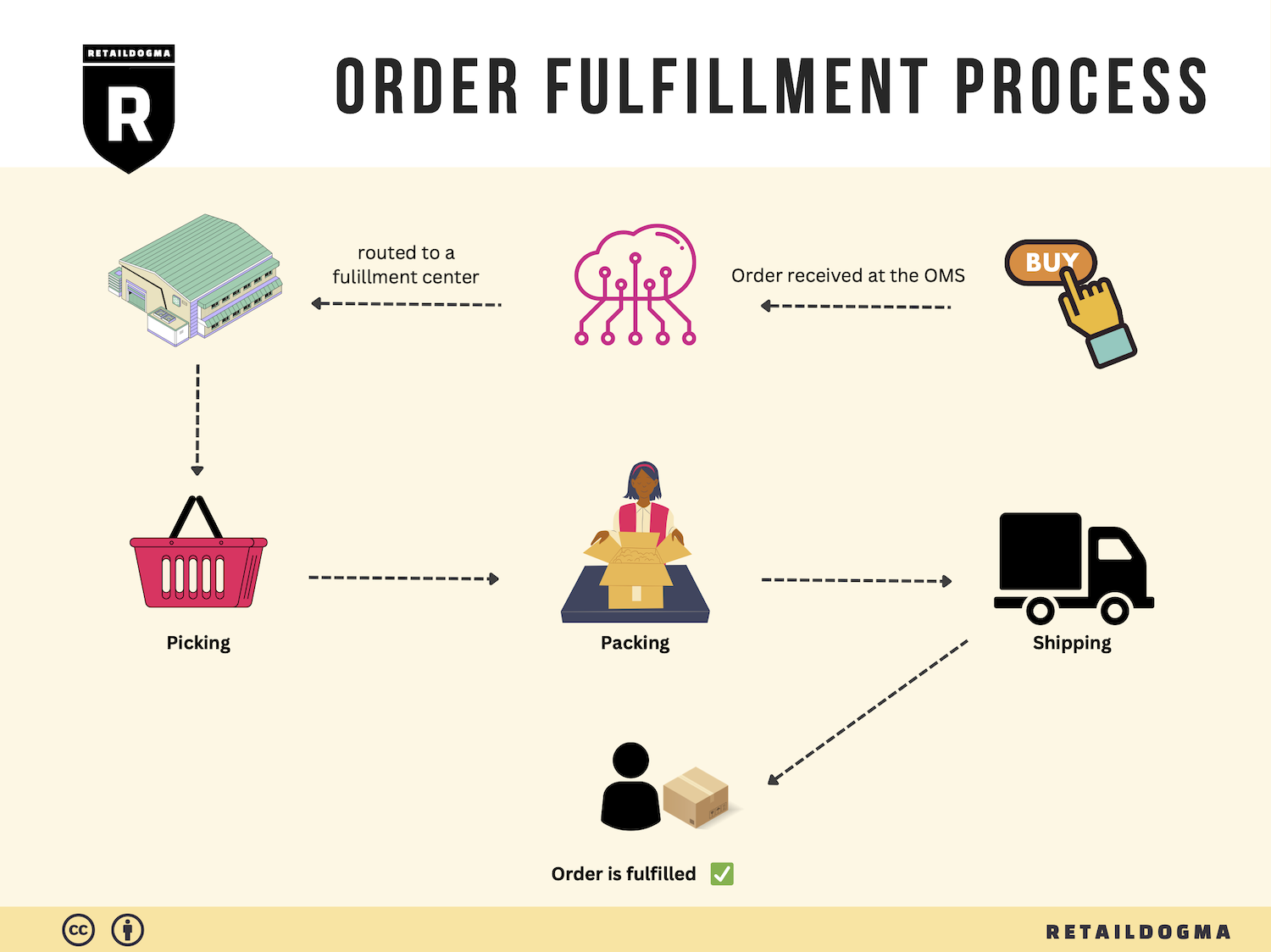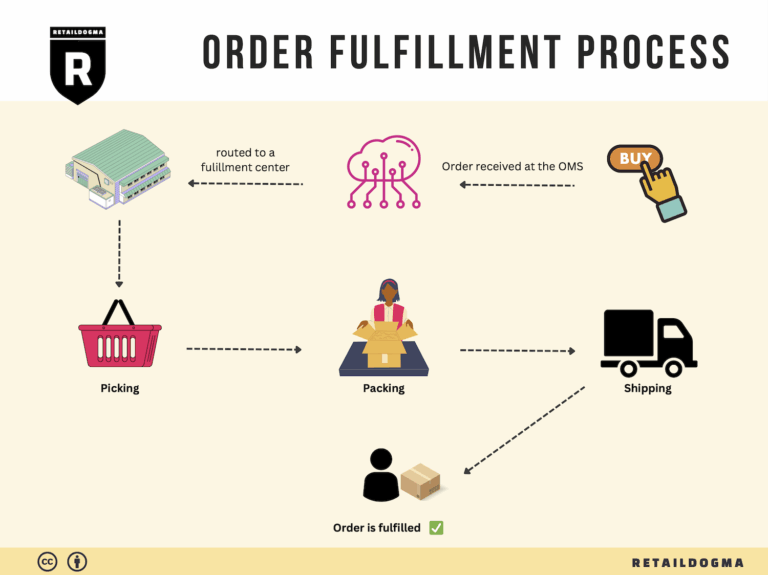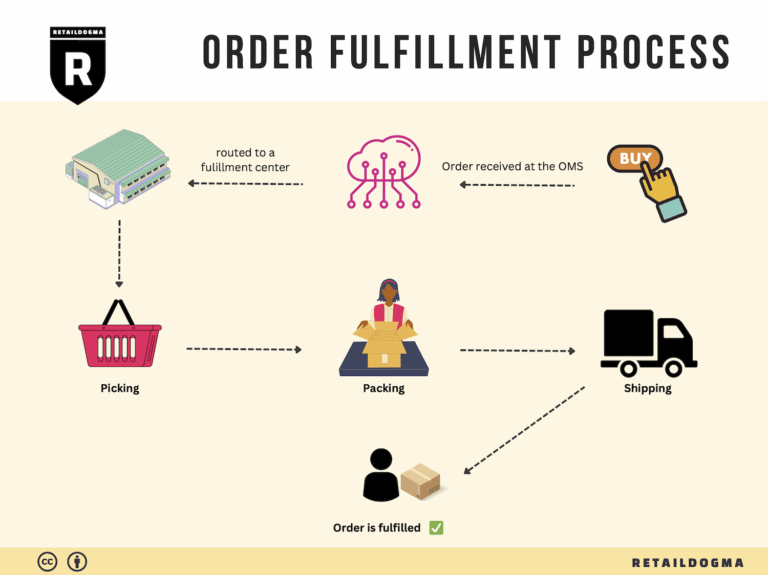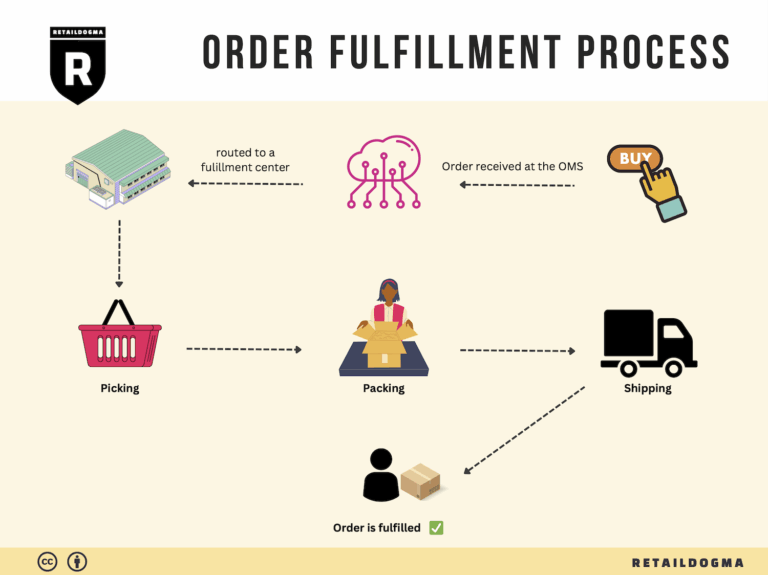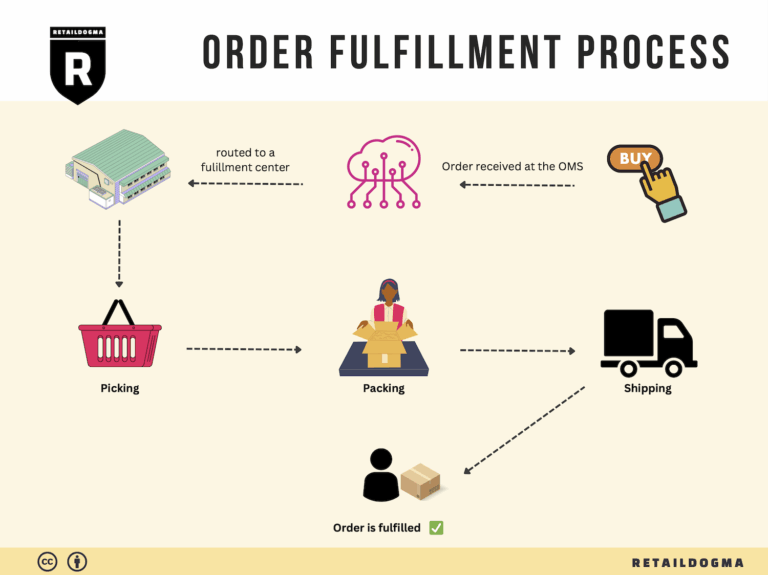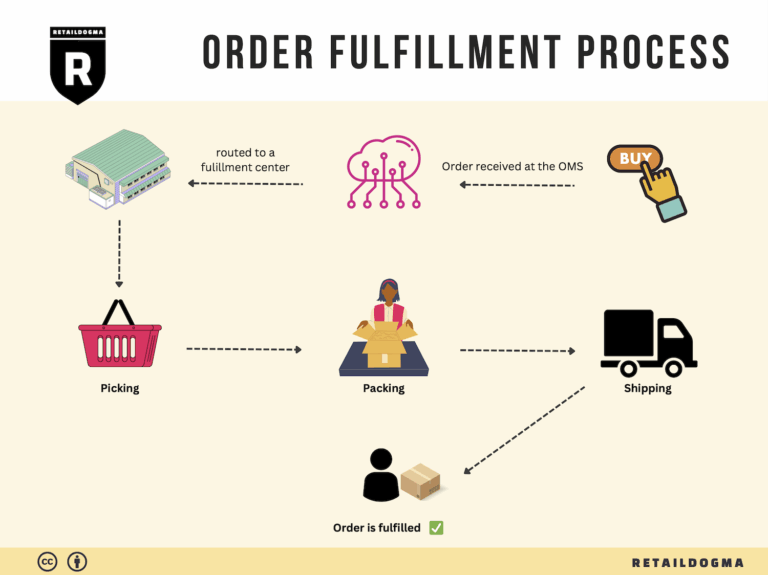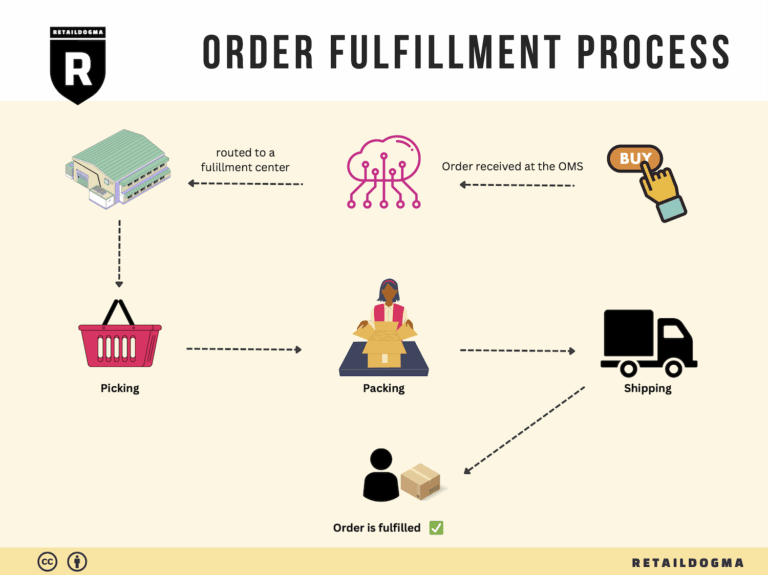How Order Fulfillment Works: A Step-by-Step Guide for Businesses
What is E-commerce Fulfillment? An Introduction for Growing Businesses
Understanding E-commerce Fulfillment
As an e-commerce business owner, you may have experienced the overwhelming challenge of managing packing and shipping orders. The excitement of growing sales often brings a host of logistical headaches, from inventory management to timely delivery. This is where e-commerce fulfillment comes into play, acting as the backbone of your online business by streamlining the process of getting products to your customers efficiently and reliably.
Fulfillment, at its core, refers to the entire process of receiving, processing, and delivering orders to customers. It encompasses everything from warehousing your products to picking and packing them, and finally shipping them out. For growing businesses, understanding the nuances of fulfillment can mean the difference between satisfied customers and lost sales.
In this guide, we will delve into various fulfillment models that can cater to your unique business needs. You’ll learn about Third-Party Logistics (3PL) providers, which manage your inventory and shipping for you, and Fulfillment by Amazon (FBA), where Amazon takes care of storage, packing, and shipping in exchange for a fee. Each model has its own set of advantages and challenges, and selecting the right one is crucial for your business growth.
We will also cover the core services offered by fulfillment partners, including inventory management, order processing, returns handling, and shipping options. Understanding these services will empower you to evaluate potential partners effectively.
Choosing the right fulfillment partner can be daunting, but it doesn’t have to be. We’ll provide actionable insights on what to look for in a partner, such as their technology capabilities, service levels, and geographic reach. Pricing is another critical factor; we will break down the costs associated with different fulfillment options, helping you make informed financial decisions.
Ultimately, this guide aims to empower you—whether you’re a business owner, operations manager, or entrepreneur—to make smart logistics choices that can elevate your e-commerce operations. By understanding the fulfillment landscape, you can streamline your processes, improve customer satisfaction, and scale your business efficiently.
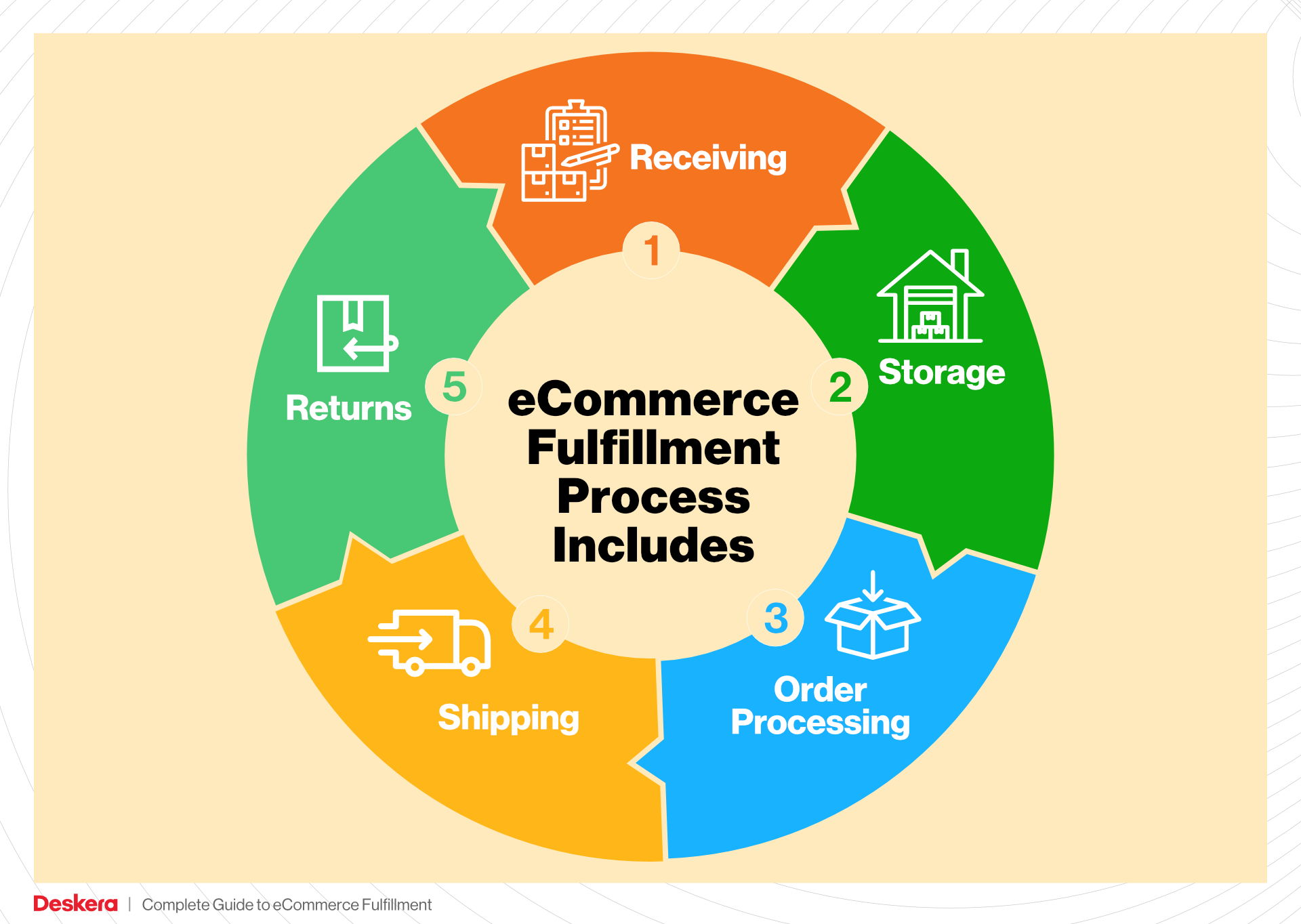
What You’ll Learn In This Guide
- What is E-commerce Fulfillment? An Introduction for Growing Businesses
- The Order Fulfillment Process: From ‘Buy’ Button to Customer’s Door
- Comparing Fulfillment Models: In-House vs. 3PL vs. Dropshipping
- A Deep Dive into Amazon FBA: Pros, Cons, and Who It’s For
- Core Services Offered by Fulfillment Centers
- How to Choose a Fulfillment Partner: A 6-Point Checklist
- Understanding Fulfillment Pricing: A Breakdown of Common Fees
- Frequently Asked Questions (FAQs) about Fulfillment
- Conclusion: Is Outsourcing Fulfillment the Right Move for Your Business?
- Important Disclaimer
The Order Fulfillment Process: From ‘Buy’ Button to Customer’s Door
1. Receiving Inventory
The first step in the order fulfillment process is receiving inventory into the fulfillment center. When products arrive at the Amazon Fulfillment Center-MDW7, they are carefully checked against purchase orders to ensure accuracy. This involves verifying quantities, inspecting for damage, and confirming that the correct items have been delivered.
Importance: This step is critical because it sets the foundation for the entire fulfillment process. If errors occur at this stage, they can propagate through to later steps, resulting in delays and customer dissatisfaction. Accurate receiving minimizes discrepancies and ensures that the inventory recorded in the system reflects what is physically available.
Key Term: SKU (Stock Keeping Unit) – A unique identifier assigned to each product to track inventory levels effectively. Using SKUs allows for precise management of stock and simplifies the process of locating items in the warehouse.
2. Warehouse Storage
Once the inventory is received, the next step is warehouse storage. Products are organized and stored in designated locations within the fulfillment center. The layout of the warehouse is strategically designed to facilitate easy access and efficient use of space.
Importance: Proper storage is vital for optimizing the picking process and maintaining an organized inventory. Effective warehouse management reduces the time it takes to retrieve items when orders come in, which can significantly impact overall fulfillment speed.
Key Term: Bin Location – A specific area within the warehouse where products are stored. By utilizing bin locations, fulfillment centers can enhance inventory accuracy and streamline the picking process.
3. Order Picking
As orders are placed by customers, the next step is order picking, where items are retrieved from their storage locations to fulfill each order. Fulfillment centers like MDW7 use various picking methods, including single order picking and batch picking, depending on the volume and nature of the orders.
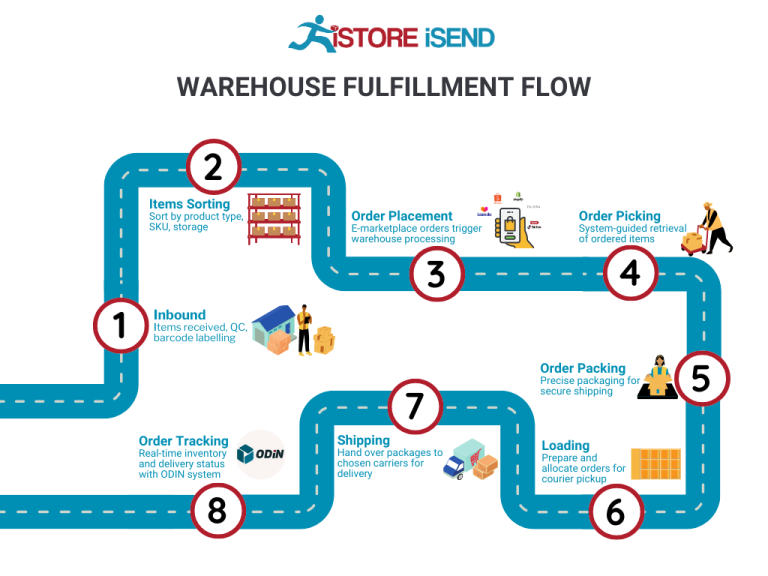
Importance: Efficient order picking is crucial to meeting customer expectations for timely delivery. The speed and accuracy of this process can directly influence customer satisfaction and retention rates. Errors during picking can lead to incorrect orders, which further complicates the fulfillment process and may incur return costs.
Key Term: Pick Lists – A document or digital list that outlines the items needed for each order, including their locations in the warehouse. Pick lists help streamline the picking process and ensure that all items are collected accurately.
4. Order Packing
After items are picked, they move to the packing stage. During this phase, the picked products are carefully packed into boxes or envelopes, along with any necessary documentation such as packing slips or return labels. The packing process also includes ensuring that the items are secure and that packaging is suitable for transport.
Importance: Packing is a vital step in protecting products during transit and ensuring that they arrive at the customer’s door in perfect condition. Well-packed items reduce the risk of damage and returns, which can significantly affect a business’s bottom line.
Key Term: Packing Slip – A document included in the package that outlines the items shipped. This not only serves as a receipt for the customer but also acts as a verification tool for the fulfillment center.
5. Shipping & Delivery
The final step in the order fulfillment process is shipping and delivery. Once packages are packed, they are labeled and handed off to shipping carriers for delivery. The fulfillment center coordinates with various logistics partners to ensure that the packages are dispatched promptly and tracked throughout their journey.
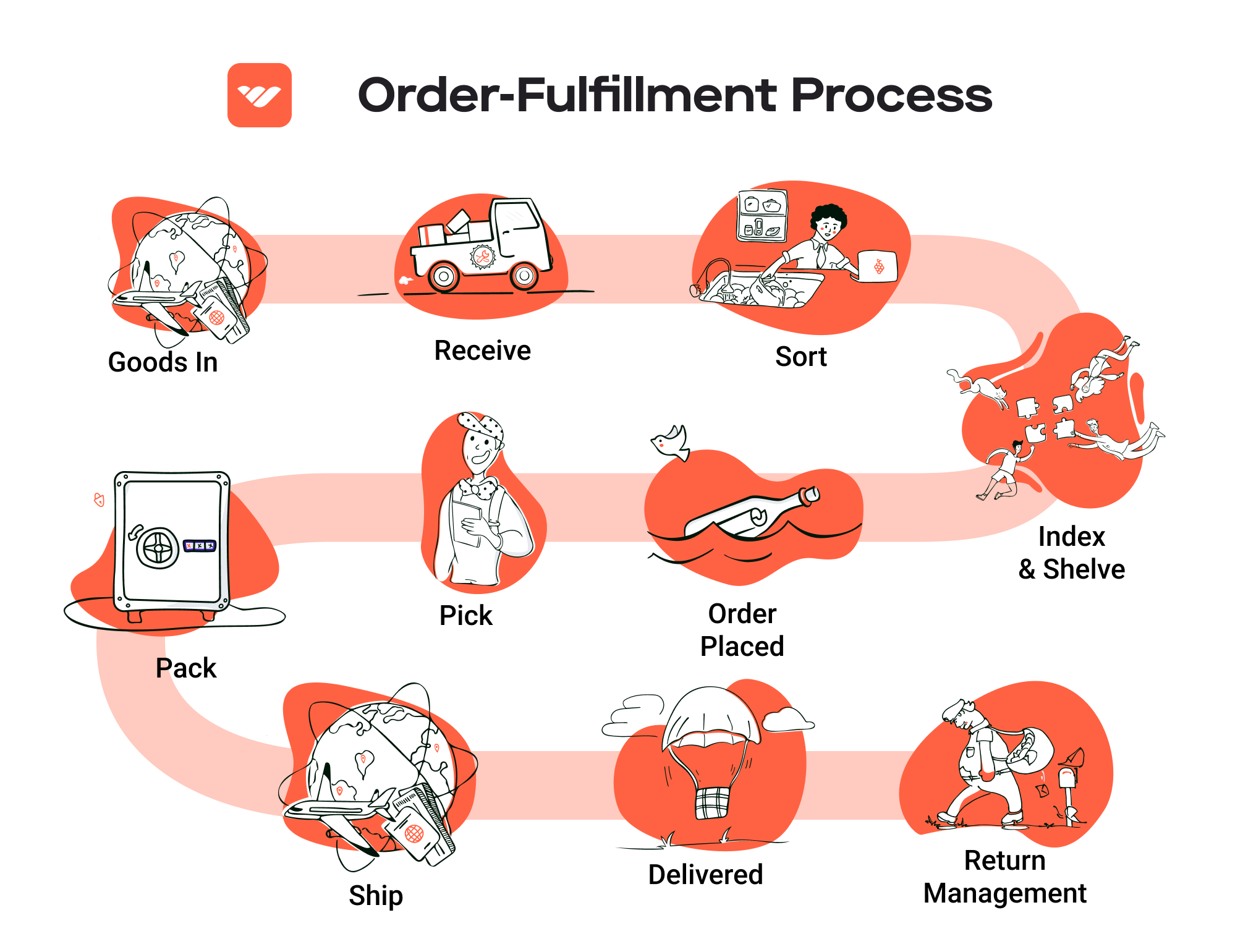
Importance: This stage is crucial for the final customer experience. Fast and reliable shipping enhances customer satisfaction and can lead to repeat business. Effective shipping strategies, including real-time tracking, can also reduce customer inquiries and enhance the perception of reliability.
Key Term: Last-Mile Delivery – The final step of the delivery process where the package is transported from a distribution center to the customer’s doorstep. Optimizing last-mile delivery is essential for improving delivery times and reducing costs.
In conclusion, understanding each step of the order fulfillment process is essential for e-commerce business owners and operations managers. By focusing on efficiency, accuracy, and customer satisfaction throughout these stages, businesses can scale effectively and maintain a competitive edge in the e-commerce landscape.
Comparing Fulfillment Models: In-House vs. 3PL vs. Dropshipping
Fulfillment Model Comparison
| Model | Who Handles Inventory | Best For (Business Stage) | Key Advantage | Key Disadvantage |
|---|---|---|---|---|
| In-House Fulfillment | The business itself | Established businesses | Full control over inventory and processes | High overhead costs and resource requirements |
| Third-Party Logistics (3PL) | External logistics provider | Scaling businesses | Scalability and reduced operational burden | Less control over inventory and processes |
| Dropshipping | Supplier | Startups and small businesses | Low upfront investment and risk | Lower profit margins and reliance on suppliers |
In-House Fulfillment
In-house fulfillment involves a business managing its own inventory and logistics operations. This model is typically adopted by established businesses that have the resources to handle warehousing, order processing, and shipping. The primary advantage of in-house fulfillment is the complete control it offers over inventory management, product quality, and customer service. Businesses can implement their own processes, ensuring that they meet their specific operational standards and customer expectations. However, this model comes with significant overhead costs, including warehousing expenses, staffing, and technology investments. As a result, in-house fulfillment may not be sustainable for smaller businesses or those looking to scale rapidly, as the resource requirements can be daunting.
Third-Party Logistics (3PL)
Third-party logistics (3PL) refers to outsourcing logistics and fulfillment operations to an external provider. This model is ideal for businesses that are in the scaling phase and seek to reduce their operational burden while maintaining a focus on core competencies. 3PL providers can offer a range of services, including warehousing, inventory management, and shipping, which allows businesses to leverage the provider’s expertise and infrastructure. One of the key advantages of using a 3PL is scalability; businesses can adjust their logistics needs based on demand without the need for substantial capital investment. However, relying on a 3PL also means giving up some control over inventory and fulfillment processes, which can lead to challenges in maintaining brand standards and customer satisfaction if the provider does not meet expectations.
Dropshipping
Dropshipping is a fulfillment model where the retailer does not hold inventory but instead relies on suppliers to ship products directly to customers. This model is particularly appealing for startups and small businesses due to its low upfront investment and minimal risk. Retailers can offer a wide range of products without the need for warehousing or inventory management, allowing them to focus on marketing and sales. The primary advantage of dropshipping is the flexibility it offers in terms of product offerings and operational management. However, this model also comes with significant drawbacks, including lower profit margins and a heavy reliance on suppliers for product quality and shipping times. Additionally, the lack of control over inventory can lead to stock issues, potentially impacting customer satisfaction and brand reputation.
Conclusion
Choosing the right fulfillment model is crucial for e-commerce businesses, as each option presents unique advantages and challenges. In-house fulfillment provides control and customization but at a high operational cost. Third-party logistics (3PL) offers scalability and efficiency, making it suitable for growing businesses, while dropshipping presents a low-risk entry point for startups but comes with challenges related to profit margins and supplier reliability. Business owners must carefully assess their current stage, resources, and long-term goals to select the fulfillment model that aligns best with their operational strategy.
A Deep Dive into Amazon FBA: Pros, Cons, and Who It’s For
Understanding Fulfillment by Amazon (FBA)
Fulfillment by Amazon (FBA) is a service offered by Amazon that enables sellers to store their products in Amazon’s fulfillment centers. Amazon takes care of storage, packaging, and shipping, allowing sellers to focus on other aspects of their business. When a customer makes a purchase, Amazon handles the entire order fulfillment process, including customer service and returns. This service is particularly advantageous for e-commerce businesses looking to scale quickly and efficiently.
How FBA Works
-
Product Listing: Sellers create product listings on Amazon and select FBA as their fulfillment method.
-
Inventory Shipment: Sellers ship their products to Amazon’s fulfillment centers, such as the MDW7 center in Monee, IL, which specializes in efficient storage, packing, and shipping.
-
Storage: Once products arrive at the fulfillment center, Amazon stores them until they are sold.
-
Order Fulfillment: When a customer places an order, Amazon picks, packs, and ships the product directly to the customer.
-
Customer Service: Amazon also handles all customer service inquiries and returns, providing a seamless experience for both sellers and customers.
-
Payment: After the sale, Amazon processes the payment and transfers the earnings to the seller, minus any applicable fees.
Pros of Using FBA
Prime Eligibility
One of the most significant advantages of using FBA is the automatic eligibility for Amazon Prime. Products fulfilled by Amazon are marked with the Prime badge, making them more attractive to millions of Prime members who prefer faster shipping options. This can significantly boost sales, as Prime members tend to purchase more frequently.
Customer Trust
Amazon is synonymous with reliability and trust. By using FBA, sellers can leverage Amazon’s reputation, which can enhance customer confidence in their products. Customers are more likely to buy from a seller that offers the backing of Amazon’s fulfillment services, especially when it comes to returns and customer service.
Multi-Channel Fulfillment
FBA isn’t limited to sales on Amazon alone. Sellers can utilize FBA for orders from other platforms, such as their own websites or eBay, through Amazon’s Multi-Channel Fulfillment (MCF) service. This versatility allows businesses to streamline their operations and maintain a consistent inventory management system across different sales channels.
Cons of Using FBA
High Fees
While FBA offers numerous benefits, it also comes with costs. Sellers must pay storage fees for their products stored in Amazon’s warehouses and fulfillment fees for each unit sold. These fees can accumulate quickly, especially for slow-moving inventory or larger items, potentially eating into profit margins.
Strict Inventory Rules
Amazon has strict guidelines regarding inventory management, including limits on the amount of stock that can be stored in their facilities. Sellers must continuously monitor their inventory levels to avoid overstocking, which can lead to increased storage fees or even the removal of their products from the fulfillment center.
Commingling Risks
FBA utilizes a commingling method where products from different sellers are stored together. While this can enhance efficiency, it poses a risk for sellers. If a customer returns a product, there’s a possibility that the returned item could come from another seller, leading to potential issues with quality control and brand reputation.
Who is FBA Best For?
FBA is particularly suited for small to medium-sized e-commerce businesses looking to scale their operations without the need for extensive logistics infrastructure. Here are some specific scenarios where FBA might be the best fit:
-
New Sellers: Entrepreneurs just starting out can benefit from FBA’s established logistics network and customer trust, which can help them gain traction in a competitive market.
-
Businesses with High Sales Volume: Companies that experience high sales volume can take advantage of Amazon’s ability to handle large quantities of orders efficiently.
-
Sellers with Limited Resources: For businesses without the means to manage their own warehousing and shipping, FBA provides a cost-effective solution to fulfill orders while focusing on product development and marketing.
-
Brands Looking to Enhance Visibility: Companies aiming to reach a larger audience can leverage Amazon’s vast customer base, especially those who want to tap into Prime members.
In conclusion, while FBA offers a range of benefits that can significantly enhance the scalability and efficiency of e-commerce operations, it is essential for sellers to weigh these advantages against the potential downsides. By understanding the intricacies of FBA and assessing their business needs, sellers can make informed decisions that align with their growth strategies.
Core Services Offered by Fulfillment Centers
Inventory Management & Warehousing
Inventory management and warehousing are foundational services provided by fulfillment centers. This involves the systematic tracking and storage of products within a controlled environment. Fulfillment centers like Amazon’s MDW7 utilize advanced software systems to manage stock levels, monitor inventory turnover, and forecast demand trends.
Benefits:
1. Real-Time Visibility: E-commerce businesses gain real-time insights into inventory levels, which helps in making informed purchasing decisions and avoiding stockouts or overstock situations.
2. Space Optimization: Fulfillment centers are designed to maximize storage efficiency, allowing businesses to store more products without the overhead costs associated with maintaining a private warehouse.
3. Scalability: As your business grows, fulfillment centers can easily scale your inventory capacity without requiring significant investments in infrastructure.
Pick and Pack Services
Pick and pack services refer to the process of selecting items from inventory (picking) and preparing them for shipment (packing). Fulfillment centers streamline this process through technology and trained personnel to ensure speed and accuracy.
Benefits:
1. Increased Efficiency: Automated systems and optimized workflows reduce the time it takes to fulfill orders, leading to faster shipping times and improved customer satisfaction.
2. Accuracy: Advanced picking technologies, such as barcode scanning, minimize errors in order fulfillment, reducing the likelihood of returns and enhancing customer trust.
3. Cost-Effectiveness: Outsourcing pick and pack operations can significantly lower labor and operational costs, freeing up resources for businesses to focus on growth and marketing initiatives.
Kitting and Assembly
Kitting and assembly involve combining multiple products into a single package or preparing items for sale as a complete unit. This is particularly beneficial for businesses that sell bundles, gift sets, or promotional items. Fulfillment centers can manage this process efficiently, allowing e-commerce businesses to offer unique products without the hassle of in-house assembly.
Benefits:
1. Customization: Businesses can create tailored bundles that meet specific customer needs or seasonal demands, enhancing the overall shopping experience.
2. Time Savings: By outsourcing kitting and assembly, e-commerce businesses can save valuable time and resources that can be redirected towards product development and marketing.
3. Inventory Control: Fulfillment centers can track kitted items as single units, simplifying inventory management and enabling businesses to better predict demand for bundled offerings.
Returns Management (Reverse Logistics)
Returns management, often referred to as reverse logistics, is the process of handling product returns in an efficient and customer-friendly manner. Fulfillment centers play a crucial role in streamlining this process, which can be complex and costly for e-commerce businesses.
Benefits:
1. Streamlined Processes: Fulfillment centers have established procedures for handling returns, ensuring that products are inspected, restocked, or disposed of quickly, minimizing the financial impact on the business.
2. Customer Satisfaction: A well-managed returns process can enhance customer satisfaction and loyalty. Customers are more likely to shop with a brand that offers hassle-free returns, leading to repeat business.
3. Data Insights: Analyzing return data can provide valuable insights into product quality, customer preferences, and potential areas for improvement in the sales process. This information can be leveraged to reduce future returns and enhance product offerings.
Conclusion
In conclusion, fulfillment centers like Amazon’s MDW7 offer essential services that can significantly enhance the operational efficiency of e-commerce businesses. By leveraging inventory management, pick and pack services, kitting and assembly, and returns management, businesses can focus on growth and customer satisfaction while minimizing logistical challenges. As e-commerce continues to evolve, partnering with a reliable fulfillment center can provide a competitive edge in the marketplace.
How to Choose a Fulfillment Partner: A 6-Point Checklist
Location & Warehouse Network
Why It’s Important:
The geographical location of your fulfillment partner’s warehouses significantly impacts shipping times and costs. A partner with a well-distributed network can help you reach your customers faster, which is crucial in today’s e-commerce environment where consumers expect rapid delivery.
Questions to Ask:
– What is the location of your warehouses, and how do they align with my target market?
– How many fulfillment centers do you operate, and what is their capacity?
– Can you provide insights into your shipping rates and delivery times for various regions?
Technology & Integrations
Why It’s Important:
Efficient fulfillment relies heavily on technology. A partner that utilizes advanced technology can streamline operations, reduce errors, and enhance customer satisfaction. Integration capabilities with your existing systems (like your e-commerce platform) are crucial for real-time inventory management and order processing.
Questions to Ask:
– What fulfillment management software do you use, and how does it integrate with my e-commerce platform?
– Can your system provide real-time inventory updates and tracking information?
– How do you handle data security and compliance with regulations like GDPR?
Specializations (e.g., cold storage, oversized items)
Why It’s Important:
Different products require different handling and storage conditions. If your business sells specialized items, such as perishable goods or oversized products, it’s essential to partner with a fulfillment center that can accommodate those specific needs.
Questions to Ask:
– What types of products do you specialize in handling?
– Do you have facilities for temperature-sensitive items or oversized goods?
– Can you accommodate custom packaging requirements?
Scalability & Capacity
Why It’s Important:
As your business grows, your fulfillment needs will evolve. A partner that can scale with your growth ensures that you can meet increasing customer demand without facing bottlenecks. Understanding their capacity limits helps prevent operational disruptions during peak seasons.
Questions to Ask:
– What is your capacity for handling increased order volumes, especially during peak seasons?
– How quickly can you scale operations if my business experiences sudden growth?
– What contingency plans do you have in place for unexpected surges in demand?
Pricing and Contracts
Why It’s Important:
Understanding the pricing structure and contract terms of your fulfillment partner is crucial to maintaining profitability. Transparent pricing models will help you budget accurately and avoid unexpected fees.
Questions to Ask:
– Can you provide a detailed breakdown of your pricing structure?
– Are there any additional fees I should be aware of (e.g., storage, handling, shipping)?
– What is the length of your contracts, and what are the terms for early termination or changes?
Customer Support & Reviews
Why It’s Important:
Reliable customer support is vital for resolving issues swiftly and maintaining smooth operations. Additionally, reviews and testimonials from other clients can provide valuable insights into a partner’s reliability and service quality.
Questions to Ask:
– What types of customer support do you offer (e.g., phone, email, live chat)?
– How quickly can I expect a response to support inquiries?
– Can you provide references or case studies from current or past clients?
Conclusion
Choosing the right fulfillment partner is a critical decision that can significantly impact your e-commerce operations. By systematically evaluating potential partners based on the criteria outlined in this checklist, you can make an informed choice that aligns with your business goals and customer expectations. Remember, the right partner not only fulfills orders but also supports your overall growth strategy.
Understanding Fulfillment Pricing: A Breakdown of Common Fees
Initial Setup Fees
When partnering with a fulfillment center like Amazon’s MDW7, the initial setup fees are often the first cost to consider. These fees can include account setup, integration with your e-commerce platform, and initial training on using the fulfillment system. The calculation for these fees typically depends on the complexity of your requirements and the level of customization needed for your business operations. For example, businesses requiring specialized software integration may incur higher fees compared to those using standard solutions.
Receiving Fees
Receiving fees are charged for the process of accepting your inventory into the fulfillment center. This fee is generally calculated per item or per pallet received. It includes the cost of inspecting, sorting, and entering the inventory into the system. The fees may vary based on the volume of items being received; larger shipments can sometimes benefit from reduced rates. Understanding your inventory turnover can help optimize these costs, as consistent shipments may lead to more favorable pricing structures.
Storage Fees (per pallet/bin)
Storage fees are ongoing costs associated with keeping your products in the fulfillment center. These fees are typically calculated on a per-pallet or per-bin basis and can vary based on the time of year. For instance, storage costs may be higher during peak seasons, such as holidays, due to increased demand and limited space. It’s crucial to monitor your inventory levels and sales forecasts to avoid unnecessary storage fees, as excess inventory can quickly lead to increased costs.
Pick & Pack Fees (per item/order)
Pick and pack fees cover the labor and materials involved in retrieving items from storage and packaging them for shipment. These fees are usually charged per item or per order, depending on the fulfillment center’s pricing model. The complexity of the order can also impact the fee; for example, orders with multiple items or special packaging requirements may incur higher costs. To manage these fees effectively, consider optimizing your product offerings and order sizes to minimize the number of picks and packs needed.
Shipping Fees
Shipping fees represent the cost of delivering your products to customers. These fees can vary widely based on factors such as the destination, shipping method, and carrier used. Many fulfillment centers offer tiered pricing based on volume, meaning that higher shipping volumes can lead to lower per-unit costs. Understanding your customer demographics and shipping preferences is essential for accurately estimating these fees. Additionally, leveraging fulfillment centers’ partnerships with carriers can provide more competitive shipping rates.
Conclusion: Tips for Getting an Accurate Quote
To obtain an accurate fulfillment pricing quote, it’s essential to provide comprehensive details about your business’s specific needs. Here are some tips to ensure you get the best estimate:
-
Inventory Details: Clearly communicate the types of products you’ll be storing, including dimensions and weight, as these factors influence storage and shipping fees.
-
Order Volume: Provide estimates for your expected order volume, as many fulfillment centers offer discounts for higher volumes.
-
Service Requirements: Specify any special services you may need, such as kitting, labeling, or custom packaging, which can affect pricing.
-
Shipping Preferences: Share your preferred shipping methods and destinations to receive tailored shipping rate options.
-
Seasonality: Inform the fulfillment center about seasonal fluctuations in your business, as this may impact storage and shipping costs.
By approaching the quote process with detailed information, you can better understand the fulfillment pricing model and identify the most cost-effective solutions for your e-commerce business.
Frequently Asked Questions (FAQs) about Fulfillment
1. What is the Amazon Fulfillment Center MDW7?
Amazon Fulfillment Center MDW7 is a large-scale logistics facility located at 6521 W Monee Manhattan Rd, Monee, IL. It specializes in storing, packing, and shipping a diverse range of products for Amazon, playing a critical role in the company’s extensive distribution network. The center is designed to handle a high volume of orders daily, ensuring timely delivery to customers.
2. How does MDW7 ensure efficient order fulfillment?
MDW7 employs advanced technology and streamlined processes to enhance operational efficiency. This includes automated systems for inventory management, picking, packing, and shipping, which help minimize errors and expedite order processing. Additionally, the center’s strategic location supports quick transportation routes, facilitating faster deliveries.
3. What types of products are stored at MDW7?
MDW7 stores a wide variety of products, including electronics, household items, clothing, and more. This diversity allows Amazon to cater to a broad customer base and fulfill orders for numerous categories, enhancing the shopping experience for consumers.
4. What is the difference between a warehouse and a fulfillment center?
A warehouse primarily focuses on storing goods, while a fulfillment center is designed to handle the entire process of order fulfillment, including picking, packing, and shipping. Fulfillment centers often integrate advanced technology to streamline operations and improve delivery times, making them essential for e-commerce businesses.
5. What is a 3PL (Third-Party Logistics)?
A 3PL is a service provider that manages logistics and supply chain operations for businesses. This includes warehousing, order fulfillment, transportation, and distribution. Partnering with a 3PL can help e-commerce businesses scale efficiently without the overhead of managing their own logistics infrastructure.
6. How much do fulfillment services cost?
Fulfillment service costs vary based on factors such as order volume, storage space, and specific services required (e.g., packing, shipping). On average, businesses can expect to pay a combination of storage fees (per cubic foot) and fulfillment fees (per order or per item). It’s essential to evaluate different providers to find a cost structure that aligns with your business model.
7. Can small businesses use Amazon Fulfillment Center MDW7?
Yes, small businesses can utilize Amazon’s fulfillment services through the Fulfillment by Amazon (FBA) program. This allows sellers to store their products at MDW7 and other Amazon fulfillment centers, leveraging Amazon’s logistics network to reach customers quickly and efficiently.
8. How do I get my products to MDW7 for fulfillment?
To send products to MDW7, you need to create a shipping plan through your Amazon Seller Central account. This plan will outline the products you are sending, quantities, and packaging requirements. Once prepared, you can ship your products directly to the MDW7 facility, where they will be received and stored for fulfillment.
9. What are the benefits of using a fulfillment center like MDW7?
Using a fulfillment center like MDW7 offers several advantages, including:
– Speed: Faster order processing and shipping times.
– Scalability: Ability to handle fluctuations in order volume without additional infrastructure.
– Cost-Effectiveness: Reduced overhead costs compared to managing in-house logistics.
– Focus on Core Business: Allows businesses to concentrate on sales and marketing rather than logistics.
10. How can I track my orders fulfilled by MDW7?
Order tracking for products fulfilled by MDW7 is integrated within the Amazon platform. Customers receive tracking information via email once their order is shipped, and sellers can monitor the status of their shipments through their Amazon Seller Central dashboard. This transparency helps maintain customer satisfaction and allows businesses to manage expectations effectively.
Conclusion: Is Outsourcing Fulfillment the Right Move for Your Business?
Evaluating the Benefits of Outsourcing Fulfillment
Outsourcing fulfillment can be a transformative decision for e-commerce businesses seeking to scale efficiently. One of the primary advantages is time savings. By entrusting fulfillment tasks to a specialized partner, business owners can redirect their focus toward strategic initiatives such as marketing, product development, and customer engagement. This shift not only enhances productivity but also allows teams to innovate rather than get bogged down in operational minutiae.
Another significant benefit is scalability. As demand fluctuates, especially during peak seasons, a reliable fulfillment partner can quickly adapt to changing order volumes without the need for businesses to invest in additional infrastructure or personnel. This flexibility can be crucial for maintaining service levels and customer satisfaction as your business grows.
Expertise is also a critical factor. Fulfillment centers, like Amazon’s MDW7 in Monee, IL, are equipped with advanced technology and processes designed to optimize inventory management, order accuracy, and shipping efficiency. Leveraging this expertise can lead to improved delivery times and reduced operational errors, ultimately enhancing the customer experience.
However, it is vital to choose the right fulfillment partner. The wrong choice can lead to increased costs, poor service levels, and damage to your brand’s reputation. Conduct thorough research, assess potential partners against your specific needs, and ensure they align with your growth objectives.
As a strategic next step, consider auditing your current shipping processes. Identify areas of inefficiency, customer pain points, and potential cost savings. This analysis will provide clarity on whether partnering with a fulfillment service is the right move for your business. By taking this proactive approach, you can position your company for sustainable growth in a competitive marketplace.
Important Disclaimer
⚠️ Important Disclaimer
The information in this guide is for educational purposes. Fulfillment services, pricing, and platform features change frequently. Always conduct your own due diligence and consult with providers directly before making business decisions.
